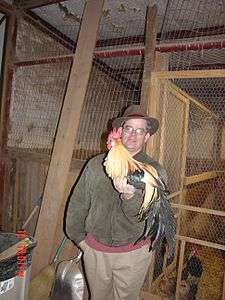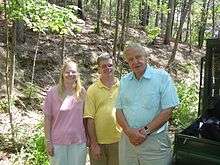Malcolm L. McCallum
Malcolm L. McCallum (born December 26, 1968 in Maywood, Illinois[1]) is an American environmental scientist, conservationist, herpetologist, and natural historian and is known for his work on the Holocene Extinction. He is also a co-founder of the herpetology journal, Herpetological Conservation and Biology.[2] His research has been covered by David Attenborough,[3] Discover Magazine,[4] and other media outlets.
Malcolm L. McCallum | |
|---|---|
 Malcolm McCallum at his home in Texarkana circa 2008 with a bantam golden phoenix rooster | |
| Born | December 26, 1968 |
| Nationality | United States |
| Alma mater | Arkansas State University |
| Scientific career | |
| Fields | Environmental Sciences |
Education, research, teaching and service
In 1997 his discovery of deformed frogs in Madison County, Illinois[5] received media coverage in St. Louis news outlets.[6] He then worked at the St. Louis Children's Aquarium as the institution's grant writer, and designed educational programs, conducted research on the use of bovine somatotropin (bST) applications in aquaculture, and delivered tours and extension programming until he left to pursue his PhD in 1999. He also organized and edited the First International Symposium on the conservation and sustainability of the ornamental fish industry on Rio Negro River, Manaus.[7] He participated in several areas of research that later were published by the aquarium from 1999-2001.[8] Stanley E. Trauth was his doctoral mentor.
Many of his early papers were focused on natural history, but they also cover amphibian conservation, ecological immunology, and general biology. He is widely published on the life history and conservation of Blanchard's cricket frog (Acris blanchardi ) with papers on its systematics, immunology, behavior, life history, and conservation needs. He earned the PhD degree in Environmental Science from Arkansas State University, specializing in ecotoxicology and conservation ecology. He continued this research as an Assistant Professor at Louisiana State University at Shreveport from 2003–2005.
.jpg)
In 2006 McCallum and several other scientists established the journal Herpetological Conservation and Biology.
He moved to Texas A&M University Texarkana in 2005.

McCallum used fuzzy logic in his paper, Amphibian decline or extinction? Current losses dwarf background extinction rates,[9] to compare recent extinction rates of amphibians to their rates at the k-Pg boundary. His calculations demonstrated that the losses in amphibian biodiversity in recent times represented one of the most rapid losses in biodiversity ever observed. In 2008 the study was listed by Discover Magazine as #4 among ten "landmark papers" on the topic of amphibian extinctions and declines.[4] His use of fuzzy approaches was extended to two studies addressing climate change impacts on herpetofauna.[10][11] His 2015 paper argued that species losses of vertebrate animals since 1980 have been faster that the Cretaceous–Paleogene extinction event that wiped out dinosaurs 65 million years ago, suggesting we are in a 6th mass extinction.[12][13]
In 2014 he conducted a study using Google Trends to data mine Google search data to infer public interest on the environment, and concluded that interest in the environment had fallen since 2004.[14]. In 2019, he compared Google searches before and after release of the landmark encyclical, Laudato Si', revealing that interest in the environment rose markedly in most countries around the world.[15][16]
Selected bibliography
McCallum is the author of over 100 publications.[17]
- McCallum, M.L. (2019) Perspective: Global country-by-country response of public interest in the environment to the papal encyclical, Laudato Si′. Biological Conservation 235:209-225.
- McCallum, M.L. (2015) Vertebrate biodiversity losses point to sixth mass extinction. Biodiversity and Conservation 24:2497-.2519.[18]
- McCallum, M.L. and G.W. Bury (2014). Public interest in the environment is falling: A Response to Ficetola (2013). Biodiversity and Conservation 23:1057-1362.
- McCallum, M.L. and J.L. McCallum. (2014). Ecological Release of an exotic species upon removal of an invasive predator. Journal of North American Herpetology 2014:21 – 27.
- McCallum, M.L., M. Matlock, J. Treas, B. Safi, W. Sanson, J.L. McCallum. (2013). Endocrine disruption of sexual selection by an estrogenic herbicide in Tenebrio molitor. Ecotoxicology 22:1461-1466.
- McCallum, M.L., and G.W. Bury. (2013). Google search patterns suggest declining interest in conservation and environment. Biodiversity and Conservation 22:1355 – 1367.
References
- Birth Announcements. Joliet Herald News. January 3, 1969
- Bury, RB, ML McCallum, SE Trauth, and RA Saumure. 2006. Dawning of Herpetological Conservation and Biology: A special welcome to your new journal. Herpetological Conservation and Biology 1(1):i-iii.
- Life in Cold Blood. "The Land Invaders".
- Pepitone, Julianne (November 4, 2008). "10 studies that revealed the great global amphibian die-off -- and some possible solutions". Discover Magazine.
- McCallum, M.L. 1999. Rana sphenocephala (southern leopard frog) malformities found in Illinois with behavioral notes. Transactions of the Illinois State Academy of Science 92:257-264.
- Kravetz, Andy (1 August 1997). "SIUE pond yields deformed frogs, questions of what they portend". St Louis Post-Dispatch. Archived from the original on 20 January 2015.
- McCallum, M.L. (Editor). Proceedings of the First International Conference on Biodiversity and Sustainability of the Rio Negro Basin Brazil. Mid-America Aquacenter Publications. St. Louis, Missouri. 1,256 pages. 1999.
- Conservation for the Oceans. World Aquarium. St. Louis. Activities 1999-2014.
- McCallum, M.L. (2007). "Amphibian decline or extinction? Current losses dwarf background rates" (PDF). Journal of Herpetology. 41 (3): 483–491. doi:10.1670/0022-1511(2007)41[483:adoecd]2.0.co;2.
- McCallum, M.L., J.L. McCallum, S.E. Trauth. 2009. Predicted climate change may spark box turtle declines. Amphibia-Reptilia 30:259-264.
- McCallum, M.L. 2010. Future Climate Change Spells Catastrophe for Blanchard’s Cricket Frog, Acris blanchardi (Amphibia, Anura, Hylidae). Acta Herpetologica 5(1):119-130.
- Rhett A. Butler (June 21, 2015). Study confirms what scientists have been saying for decades: the sixth mass extinction is real and caused by us. http://news.mongabay.com/2015/0621-sixth-mass-extinction.html
- Anonymous. (June 16, 2015). Today's biodiversity losses comprise a sixth mass extinction. BirdWatch Magazine (UK) http://www.birdwatch.co.uk/channel/newsitem.asp?c=11&cate=__15971
- McCallum, Malcolm L.; Bury, Gwendolyn W. (2013). "Google search patterns suggest declining interest in the environment". Biodiversity and Conservation. 22 (6–7): 1355–1367. doi:10.1007/s10531-013-0476-6.
- McCallum, Malcolm L. (2019-07-01). "Perspective: Global country-by-country response of public interest in the environment to the papal encyclical, Laudato Si′". Biological Conservation. 235: 209–225. doi:10.1016/j.biocon.2019.04.010. ISSN 0006-3207.
- "Interest in protecting environment up since Pope's 2015 encyclical". Mongabay Environmental News. 2019-05-21. Retrieved 2019-05-23.
- McCallum, M.L. 2010. Characterizing author citation ratings of herpetologists using Harzing’s Publish or Perish. Herpetology Notes 3:239-245.
- McCallum, Malcolm (September 2015). "Vertebrate biodiversity losses point to a sixth mass extinction". Biodiversity and Conservation. 24 (10): 2497–2519. doi:10.1007/s10531-015-0940-6.